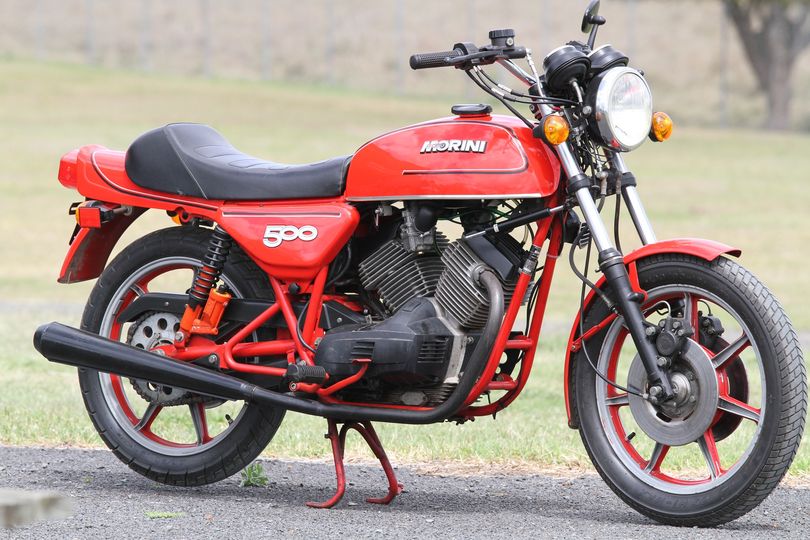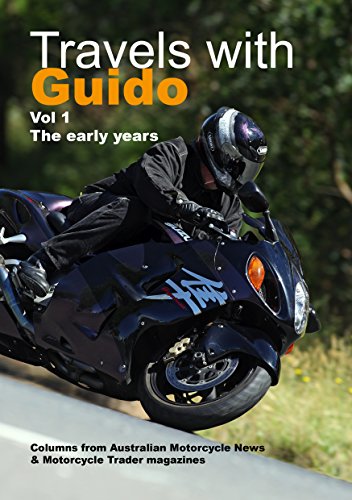Motorcycle Investor mag
Subscribe to our free email news
Moto Morini 350 & 500 twins
(by Ian Falloon, Mar 2022)

All too
often over-looked, the Morinis offer a sweet ride
During the 1970s
Italian motorcycles were best suited to romantics, and
enthusiasts who not only
rode their motorcycles, but also had a relationship with
them. Italian
machinery suffered from mechanical schizophrenia, an
intriguing blend of the
excellent and awful, the brilliant and dim-witted, and
good ideas poorly executed.
Some Italian motorcycles exhibited these characteristics
more than others, and
none more so than the Morini 500 Sport.
The 500 began its life
back in 1971 as the 350cc 3 ½. From the outset this was
a design of
contradiction. Created by Franco Lambertini, the
72-degree V-twin was
intentionally designed to reduce manufacturing costs.
72-degrees was a
compromise between the perfectly balanced 90-degree and
high vibration
45-degree layouts and Lambertini chose a Heron cylinder
head layout. This
featured an easily machined flat cylinder head with
parallel valves and the
combustion chamber incorporated in the piston crown.
During the 1960s the
Heron head found favour as it allowed a very high
compression ratio (11.2:1 in
the 500 Sport) with good flame travel as the valves were
unshrouded. The
disadvantages were only small valves could be fitted
(31.8mm intake and 26mm
exhaust). These valves were operated by pushrods, the
camshaft driven by a
toothed rubber belt.
Every aspect of the
design indicated economy. The rubber belt didn’t include
any tensioning system,
and as the cylinders were offset 50mm almost all the
rear cylinder components
from the con-rod up were identical to the front, simply
rotated 180-degrees.
And although the crankshaft and con-rods ran in plain
bearings only a wire mesh
oil filter was provided.
Further adding to the
confused specification were a dry clutch and electronic
ignition, both
extremely unusual in 1971.
Although the Heron
design was successful in the Jaguar V12, Rover’s 2000
and the ubiquitous Ford
Kent engines, it always struggled to make sufficient
power in smaller capacity
motorcycle engines.
The original Morini 3
½ produced a feeble 35 horsepower, and even in later
Sport trim was
underpowered. For 1977 Morini enlarged the bore to 69mm,
and lengthened the
stroke to 64mm to create the 500. With a pair of 26mm
Dell’Orto carburettors
the claimed power was 46 horsepower at 7500rpm.
Unfortunately this was an
optimistic claim and the 500 was little faster than the
considerably lighter 3
½, and considerably slower than any comparable Japanese
500.
But no one bought a
Morini purely for engine performance. A Morini was about
balance, handling, and
manufacturing quality; something it had in abundance.
From the exquisite engine
castings to the Marzocchi suspension, Grimeca brakes,
and Fiamm horn, a Morini
exuded quality.
By the time the 1979
500 shown here appeared, 18-inch cast alloy wheels had
replaced the Borrani
wire wheeled type, and black highlighting was strongly
evident, but the basic
formula was unchanged. This was a formula that
emphasised handling.
Although the double
cradle frame was a conventional design, the wheelbase a
longish 1443mm, and the
steering slow (with a 29 degree steering head angle),
the Morini’s handling was
superior to just about anything in the late 1970s. The
weight was only 167kg
and initiating turns and making transitions was an
absolute delight.
This was a bike on
which the rider was in absolute command at all times,
and one that could show a
clean pair of heels to bikes with considerably more
power. The handling ability
of Morinis was made evident to me many times when I
couldn’t match them on a
Ducati Pantah on fast tight downhill rides. Only going
uphill, when even
judicious use of the Morini’s five-speed gearbox
couldn’t disguise the power
deficit, could the Pantah make amends.
Living with a Morini
required dedication. Although the 500 did have a
kickstart, generally it was
easier to start with the left side lever.
Ergonomics were not
really part of the package. The ignition key was
awkwardly mounted under the
tank, the seat low with very forward mounted non-folding
footpegs, and the
gearshift vague with missed shifts. These were mainly
due to the clumsy
left-side conversion from the original right side shift.
The 500 remained in
production until the end of 1981 and was updated to the
six-speed SEI-V for
1982. This soldiered on until 1985.
Morini 3 ½ s and 500s
were never big sellers. They were far too idiosyncratic
for that and
consequently are rarely seen today. But if you do come
across one ridden in a
spirited fashion on a twisty back road, be prepared to
be surprised.
-------------------------------------------------
Produced by AllMoto abn 61 400 694 722
Privacy: we do not collect cookies or any other data.

Archives
Contact





